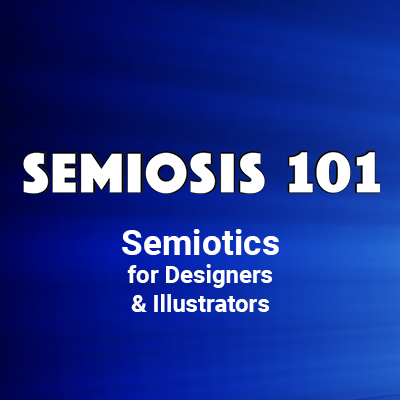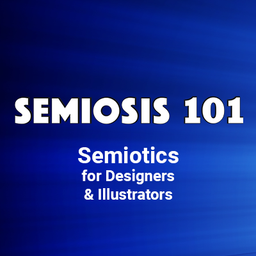Free Semiosis 101 Transcript 3.11:

WHEN IS A BIRD A BIRD? Semiotic Possibilities of Meaning-Bearing
Hello readers.
In this free transcript for the episode published on Semiosis 101 on Weds 17 January 2024, we discuss the first moment of something visual becoming some thing else in the mind of the target audience. This is only a visual possibility of greater meaning. We also explore how you are already semiotically encoding possible meaning.
Watch the free episode on YouTube for the full impact…
…and here is the episode’s transcript.
We have already discussed at length in the first few episodes, how in Semiosis, the interpretation effect of the semiotic representation on the interpreter is crucial for creatives to be aware of. The first moment of something visual becoming some thing else in the mind of the target audience, happens in the perception state that Peirce calls Firstness. This is only a visual possibility of greater meaning. Hit subscribe to this YouTube channel, and I will explain…
To emphasise this semiotic encoding of the possibility of greater meaning, let me quickly refer back to the panda illustration example I used so far. Not to analyse the drawing in semiotic terms, but instead the assumption (interpretation) that when we see a drawing of a panda it is a panda.
“Surely a drawing of a panda is a panda?” some of you may be shouting at me right now, but regular viewers (and my students) know I am tricksy. So, when is a drawing of a panda not a panda? Some of you may say when the panda drawing is Symbolic of something else, such as the WWF organisation. Here the panda is a logo representing not only the World Wildlife Fund but all endangered animals. But how else can a panda illustration not be a panda?
A drawing of a panda will not be seen as a drawing of a panda, if the interpreter does not know what a panda is. To the illustrator or designer who has created the panda drawing, they know what a panda is, what a panda looks like, and so assume the target audience will also recognise the drawing as a panda.
But at this stage, semiotically, the interpretation is only a possibility that it will be interpreted as a panda. This is what Peirce means when he frames this interpretive moment as Rhematic - a Rheme. Semiotically, the lines and shapes that define the shape of the beast are working hard to point the interpreter to the interpretation of “panda.” These lines and shapes, as we have seen in many previous episodes, are semiotic Iconic representations.
Iconic representation is the lowest level semiotic encoding, the lowest level of semiotic representation of a concept in sign-action. In Semiosis 101 I draw the comparison between Peirce’s Icon to the basic visual communication building blocks designers and illustrators use. Think of every line, shape, mark, colour, stroke, etc. as a visual communication building block. We are considering here the micro level of how illustrations and designs are created. Composited together more complex things are created. Each of those micro decisions has the capacity to be semiotically encoded as meaning-bearing. How?
Consider the black blobs in the drawing, formed in one way to suggest an ear, and formed in another way to suggest a leg. A black line stroke in a particular way to suggest a back of an animal. See? You are already semiotically encoding possible interpretation. Iconic representation is the mindful manipulation of the basic visual communication building blocks at the micro level to suggest. When a designer or illustrator uses their technical skill to make this mark suggest it is that, the mark becomes meaning-bearing. The illustrator or designer has encoded meaning into a mark.
(ASIDE: Hopefully you are quickly realising that semiotic encoding is easier than you first thought?)
The creative hopes that is how the target audience will understand what they are doing. But a successful interpretation at this stage is still only a possibility - hence Rhematic. We have seen in the first four season three episodes that this level of interpretation only has an immediate effect on the interpreter’s understanding. Iconic representation relies on visually suggesting resemblances, familiarity and possibilities of visually communicating the concept. This happens at the immediate state of effect of this representation on the interpreter.
As Iconic representation only suggests possibilities that familiarities could mean something more, the effect on the interpreter of what this something could also be is classed by Peirce as immediate. Let us consider this with an example that is not a panda.
I am a Scouser. I am from Liverpool, in England. I am a Scottish citizen. I live and work in Scotland. I am a New Scot. I am a Scouse-Scot. (Geddit?)
Semiosis 101 is a sub-brand of Scouse-Scot, and Scouse-Scot’s visual identity is of two Liver Birds against a Saltire flag. The Liver Bird is semiotically Symbolic for Liverpool. The Saltire is the national flag of Scotland. The Saltire is semiotically Symbolic for Scotland. The Saltire is blue, the birds are red. So let me unpack the visual communication building blocks of Scouse-Scot’s logo.
Blue/Red. White cross on a blue background. Red birds comprised of swirls and shapes.
Each of these visual building blocks, composed together in a particular order become meaning-bearing. In the context of the individual constructed components, they have a contextual meaning:
• a diagonal cross across a background forms what is described as a saltire;
• a diagonal WHITE cross across a BLUE background forms a cross of St Andrew, the patron saint of Scotland;
• a white and blue saltire like this has the encoded meaning-bearing power of indicating this is a flag representing the nation of Scotland
So far, so good. We hope.
The Saltire is internationally recognised as the national flag of Scotland, but certain Spanish municipalities may also lay claim to it! That is the Saltire part of the logo. That is the meaning-bearing context that the white cross on blue contributes to Scouse-Scot. But what of the birds? We can see the Liver Birds are stylistically constructed with individual visual communication building blocks. But what are they? We can see… a shape with two legs, wings, tail, head and beak.
This Iconically suggests what most of us will recognise as a bird-shape. We can say that the immediate effect of seeing all these swirling shapes, in this composition, suggests a bird… a bird shape standing proud, with outstretched wings, with in what we perceive as a beak another shape, which in turn suggests a plant. Well… what could this mean?
We can say the immediate effect here is to suggest an interpretation of “birds” in the interpreter’s mind. This is where, semiotically speaking, the interpreter …and the creative… precariously wobbles. Is it a bird? Is it a particular type of bird? What could it be? Semiotically, if the interpreter arrives at the interpretation of “bird,” the mark-making has had a successful immediate effect on the interpreter. It is a bird, and the interpreter has taken the suggestion of the known visual qualities of a bird, and decided they are looking at a bird
Job is a good’un! Well done creative and well done interpreter. But hang on… that is not all the meaning is it?
No. The creative (me) is visually communicating more. The bird has more meaning-bearing to reveal. But what? As the interpreter what are we missing? Some of you may see a familiarity in the bird’s shape to a football team. Some of you may think those birds have a resemblance to Liverpool FC’s team emblem, and you will be fairly accurate. The red football team from Liverpool indeed uses a single Liver bird. But there are two birds here.
The shared Iconic shape of the birds mediate an interpretive move from “bird” (via knowledge of a football team) to “Liver Bird.” Again, well done everybody. Job’s a good’un!
But hang on. If you all, as interpreters, did not know the contextual knowledge that on Liverpool’s riverfront, atop of the port’s grand Liver Building’s twin towers stand two birds - The Liver Birds - you would never successfully interpret this at all. Up to the point of “birds,” the semiotic encoding remains at the Iconic level of representation and the immediate effect of interpretation. But once the interpreter perceives the same Iconic image as something, the representation then (to that interpreter) POINTS them to The Liver Birds.
We say this is Indexically representing an existent thing, and now has moved from immediate to a dynamic effect of moving from an interpretation of “birds” to Liver Birds. The Rhematic possibility of “birds” has now move to what Peirce calls the Dicent level of interpretation - from a semiotically suggested possibility of “it could be” to a proposal in the interpreter’s mind that the birds are “Liver Birds.” With the interpreter’s lived experiences, a design or illustration may or may not reveal deeper understanding of what is semiotically encoded.
Come back next week, when we will have an episode on how we can semiotically encode for a dynamic effect.
PS: My family are all Blue Everton supporters!
Semiosis 101 Semiotic Design Resources is a reader-supported publication. To receive exclusive posts and support my work, consider becoming a free or paid subscriber. Paid subscribers get name checked on all future Semiosis 101 YouTube episodes.
===Semiosis 101 Patreon Producer==============
Become a Semiosis 101 Patreon Producer and get a named producer credit on future video episodes, plus watch all new episodes months ahead of YouTube.
===Semiosis 101 Patreon Exclusives==============
Watch longer Patreon-exclusive Semiosis 101 episodes on applying Semiosis into design and illustration…
PATEXC001 How does semiotics work in illustration?





